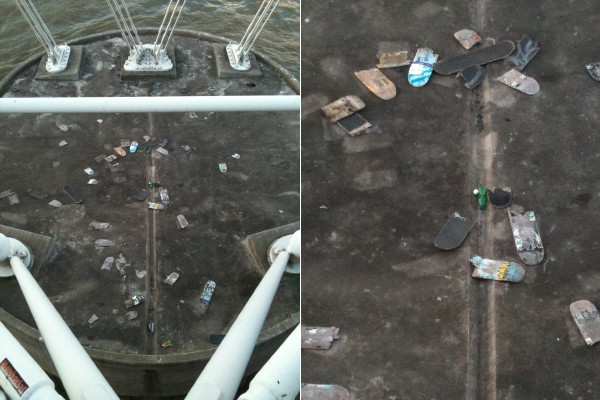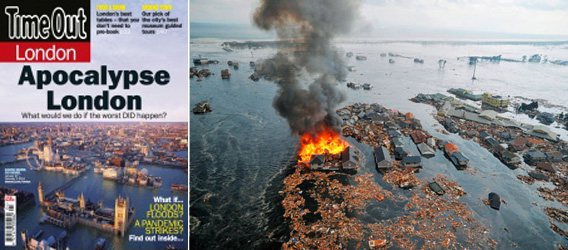
Mystery of the day. If you look down at one of the piles of the Hungerford Bridge, you will see a large number of shattered skateboards lying there for no apparent reason. I can’t for the life of me think why.

I’ve been playing more or less obsessively a newly discovered iPhone game: Tiny Tower.
It may not seem like much at first glance, with its repetitively simple gameplay and wide-eyed pixel graphics. But I would argue that a few key qualities mean it represents a whole new paradigm for portable games – games as a kind of mobile companion.
You start with a ground-floor lobby and a small amount of cash (‘coins’), and you build your tower floor by floor. You get to choose the category of floor you build (food, retail and so on) but not the specific shop that ends up being built (a diner or a shoe store, say). Each shop can be stocked with various products (which costs money), which are then sold (which earns more money). And when you have enough money, you can build another floor. Oh yes, and there are little people who work in the shops and live in apartments you must build.
It’s not brain surgery. With this description it sounds like a lobotomised version of SimCity, or indeed SimTower. But the difference is that everything happens in real time – the building of the floors, the stocking and selling of products, the waiting for people (‘bitizens’) to move in. And time passes in the game even when you’re doing something else on your phone. So you can come back after a few hours and see that that product is ready to stock now, or this new floor has been built.
Equally, there are certain things you have to be in the game to do, such as allow newly stocked products to go on sale, or to restock a sold-out product. So if you don’t play the game for a while, all your stores will sell out and you’ll stop making money – and the game will grind to a halt.
Importantly, though, you can’t ‘die’ or regress in the game by not playing it. In this way it’s not like a Tamagotchi, which you used to be able to kill through neglect. Your tower will just wait patiently for you.
Finally, there is a second form of currency in the game, a kind of reward currency (‘tower bux’) that you can spend in order to speed up how long it takes to stock or sell products, or build a floor. So you are not completely at the whim of the real-time clock, and you can make things happen when you actually want to play the game.
Although I still maintain it’s a simple game, the gameplay is very finely balanced, so that the more frequently you play the game the more quickly you can build your tower – but that you have to have time away from it too. Combined with the childish charm of having this pixellated tower and its pixellated inhabitants living in your phone wherever you go, I find myself clicking into the game every few hours, much more than any other game I have on my phone.
It’s very difficult to explain the attraction it holds, and I don’t feel I’ve managed it in the paragraphs above, but if you need a final argument here it is. The game is also psychic. Yesterday, on my wedding day, it built a wedding chapel in my tower. No, it’s not connected to Google or anything that knows I was getting married. It is pure psychic wisdom. I will start allowing it to buy me lottery tickets soon.

Photos of nebulae taken by the Hubble Space Telescope and Rankin’s close-ups of people’s irises.
Seeing a display of Japanese fiction in Waterstone’s suddenly brought it home to me how one-dimensional a vision presides of what Japanese culture is, at least in the British publishing industry. Countless book covers show the same images of submissive women and fragile blossoms, repeated in barely changing iterations. Sure, these images have their roots in Japanese visual arts, whether ukiyo-e or Araki, but there’s a distinct laziness at work here when it comes to looking past the visual stereotypes.

Am sure this happens with other national groupings of authors too. Next project: a national taxonomy of book covers?

Sitting in Pudong airport and flipping through Trading Up – “the magazine for the high class”, full of the latest luxury lifestyle advice for the country’s super-rich – I came across a picture of the 452 bus that carries me to the office most mornings. It’s understandable, with its calf-leather seats, automatic temperature control and built-in Bose stereo system. Good to know I’ve finally made it.

The front cover of Time Out London a few weeks ago showed a mock-up of an ‘apocalyptic’ London storey-deep in Thames floodwater. Lovely helicopter-aerial view, setting sunlight, floodwater as far as the horizon. And then along come early shots of the Tohoku tsunami: same aerial perspective, same angle of light (though this time from fire), same water destruction as far as the eye can see. But this is real, proven by one crucial difference: debris, the thousands of planks, files, cars, photo albums floating on top of the sea, clustering around the remaining structures. The tsunami replaced lives with the tiny objects acquired during them. After the flood, only our junk remains.



